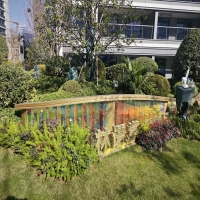Welcome to the website for landscape facilities products and knowledge.
What are the most common applications of the Landscape Round table in film or television production?
In the meticulously crafted worlds of film and television, every object on screen serves a purpose. Among the myriad of props and set pieces, the Landscape Round Table has emerged as a surprisingly versatile and frequently employed tool. Its applications extend far beyond mere furniture, becoming a silent yet powerful actor in visual storytelling.
One of the most common applications is the facilitation of group dialogue. The round table's non-hierarchical shape is perfect for scenes depicting strategy meetings, whether in a corporate boardroom or a superhero headquarters. It visually communicates equality and collaboration, allowing the camera to smoothly circle the table or cut between characters without implying a power dynamic that a long, rectangular table might. This setup is ideal for tense negotiations, brainstorming sessions, or pivotal plot revelations involving an ensemble cast.
Furthermore, the Landscape Round Table is a favorite for modern interior set design. Its sleek, often minimalist design instantly conveys a sense of contemporary style, affluence, or forward-thinking. Production designers use it to anchor a space—a chic penthouse apartment, a high-tech laboratory, or a trendy agency office. Its clean lines and open base do not obstruct the camera's view, making it a practical choice for capturing wide shots and ensuring clear sightlines between actors.
Another significant application is in the "war room" or mission control scenario. In thrillers, sci-fi, and political dramas, the Landscape Round Table often becomes the central nervous system of the operation. Characters gather around it, studying blueprints, tracking targets on digital maps, or monitoring global events on tablets and laptops placed on its surface. Its expansive area provides ample space for props that drive the narrative forward, turning the table into a stage for the action.
Beyond character interaction, the table's aesthetic serves as a powerful framing device. Directors and cinematographers use its distinct circular or oval form to create compelling compositions. A lone character sitting at the vast table can evoke feelings of isolation or overwhelming responsibility. Conversely, a table crowded with documents and characters can build a sense of urgency and chaos. It acts as a visual anchor, guiding the audience's focus and enhancing the emotional subtext of a scene.
In conclusion, the Landscape Round Table is far more than a piece of furniture; it is a multifaceted tool for directors, production designers, and cinematographers. Its primary applications—enabling dynamic group dialogue, defining modern aesthetics, centralizing high-stakes action, and serving as a compositional frame—make it an unsung hero in shaping the narrative and visual language of contemporary film and television production.
Related search:

Recommendation
Metal and acrylic color-changing combined curtain wall for large-scale public landscape facilities